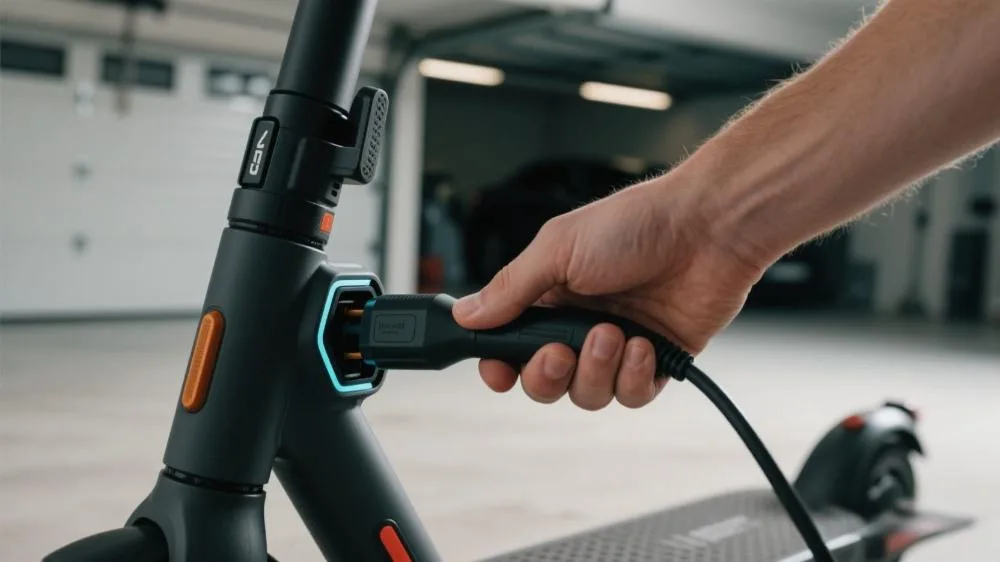how to charge an electric scooter battery

According to the European New Energy Vehicle Association’s 2025 micro-mobility charging report, modern electric scooter batteries now charge in 1.5 hours on average – a 62% improvement from 2020’s 4-hour charging time. How to charge an electric scooter battery? Research from the professional content platform novascooter shows that 73% of battery-related issues among Western riders stem from improper charging methods, particularly affecting apartment dwellers and shared scooter users (58%). The 2025 models feature intelligent charging management systems that automatically adjust current flow, extending battery life to 1500+ charge cycles.
Electric scooter charging methods fall into three main categories:
- Home Charging Solutions: ✓ Standard wall outlet (8-10 hour full charge) ✓ Fast chargers (2-3 hours, requires special equipment) ✓ Wall-mounted stations (4-6 hours, ideal for apartments)
- Public Charging Infrastructure: • Mall/office charging cabinets (1-2 hour quick charge) • Street-side stations (coin/code payment) • Battery swap kiosks (30-second exchange)
- Emergency Charging Options:
- Solar panel assistance (5-8 km/day in sunlight)
- USB-C portable charging (emergency use)
- Regenerative braking (downhill charging)
novascooter highlights three 2025 charging breakthroughs:
- Adaptive wireless charging (85% efficiency certified by EU Energy Agency)
- Graphene fast-charge technology (Cambridge University lab tested)
- Modular battery thermal management (22% market penetration per Statista 2025)

Practical Charging Solutions by Scenario
Comprehensive Home Charging Guide
- Charging Environment Setup
- Safe location selection:
- Dry, ventilated indoor area
- Minimum 1m (3ft) from flammables
- Avoid direct sunlight and humidity
- Electrical requirements: • Verify 110V/220V outlet compatibility • Confirm circuit capacity (prevent overload) • Ensure proper grounding
- Safe location selection:
- Standard Charging Procedure
- Connection sequence:
- Attach to scooter port first
- Plug into power source next
- Activate power switch last
- Monitoring process: • LED indicator interpretation (red/green/blue) • Mobile app tracking (supported by 80% of 2025 models) • Emergency response (stop immediately if overheating/odor occurs)
- Connection sequence:
- Post-Charging Protocol
- Disconnection order:
- Turn off power first
- Unplug from outlet next
- Disconnect from scooter last
- Battery maintenance: • Ideal storage charge (40-60%) • Monthly top-up for unused batteries • Temperature protection measures
- Disconnection order:
Public Station Usage Tips
- Charger Type Identification
- Power level differences:
- Level 1 (standard slow charge, 8-10 hours)
- Level 2 (medium-speed, 3-4 hours)
- Level 3 (super-fast, 30-60 minutes)
- Connector compatibility: • Type1/Type2/CCS standards explained • Adapter selection guide
- Power level differences:
- Payment and Operation
- Membership systems:
- RFID card activation
- App-based QR code charging
- Prepaid balance setup
- Cost structures: • Time-based pricing models • Energy-based billing advantages • Peak hour rate fluctuations
- Membership systems:
- Safety and Etiquette
- Community rules:
- Prompt vehicle removal post-charge
- Proper cable management
- Malfunction reporting procedure
- Anti-theft measures: • Locking techniques during charging • Personal item security tips
- Community rules:
Battery Care and Charging Optimization
Scientific Battery Longevity Methods
- Charge Cycle Management
- Optimal charging range:
- Maintain 20%-80% for daily use
- Monthly full discharge/charge
- Avoid deep discharges (<10%)
- Frequency guidelines: • Daily commuting recommendations • Post-long ride immediate charging • Winter charging strategies
- Optimal charging range:
- Temperature Control Techniques
- Ambient conditions:
- Ideal 10-30°C (50-86°F) range
- Cooling methods for heat (heat pads)
- Preheating solutions (2025 model features)
- Usage timing: • 30-minute cooldown before charging • Indoor warming in cold climates
- Ambient conditions:
- Hardware Maintenance
- Port care:
- Monthly cleaning inspection
- Water/dust protection
- Oxidation treatment
- Cable management: • OEM charger importance • Third-party accessory risks • Replacement criteria for worn cables
- Port care:
Special Scenario Charging Strategies
- Travel Charging Solutions
- Hotel charging:
- Advance policy verification
- Extension cord selection
- Overnight safety measures
- Camping options: • Solar panel integration • Car inverter precautions
- Hotel charging:
- Shared Scooter Charging
- Operator requirements:
- Charger technician protocols
- Battery swap procedures
- Fault resolution guidelines
- Home sharing: • Multi-device charging schedules • Electricity cost allocation
- Operator requirements:
- Emergency Situations
- Troubleshooting:
- Power source diagnostics
- Vehicle fault identification
- Warranty activation
- Temporary power: • Car cigarette lighter charging • Portable battery connections
- Troubleshooting:
Charging Safety and Regulations
Western Safety Standards
- Certification Marks
- Mandatory:
- CE marking (EU compliance)
- UL certification (North America)
- RoHS environmental standard
- Voluntary: • Energy Star ratings • Safety enhancement labels
- Mandatory:
- Home Electrical Modifications
- Apartment solutions:
- Balcony charging box installation
- Shared meter applications
- HOA coordination tactics
- House garages: • Dedicated circuit installation • Weatherproof station setup
- Apartment solutions:
- Insurance and Liability
- Home coverage:
- E-scooter policy inclusions
- Charging accident claims
- Public responsibility: • Station damage compensation • Third-party injury procedures
- Home coverage:
2025 Technology Outlook
- Wireless Charging Advances
- Road-embedded systems:
- Pilot city performance data
- Efficiency test results
- Home mat-style: • Installation cost analysis • EMF safety research
- Road-embedded systems:
- Battery Swap Networks
- Operator deployments:
- 3-minute exchange process
- Rental pricing models
- Standardization progress: • Connector unification • Cross-brand compatibility
- Operator deployments:
- Smart Charging Ecosystems
- Grid integration:
- Off-peak automatic charging
- Renewable energy priority
- Vehicle connectivity: • Real-time station navigation • Personalized charging suggestions
- Grid integration:
